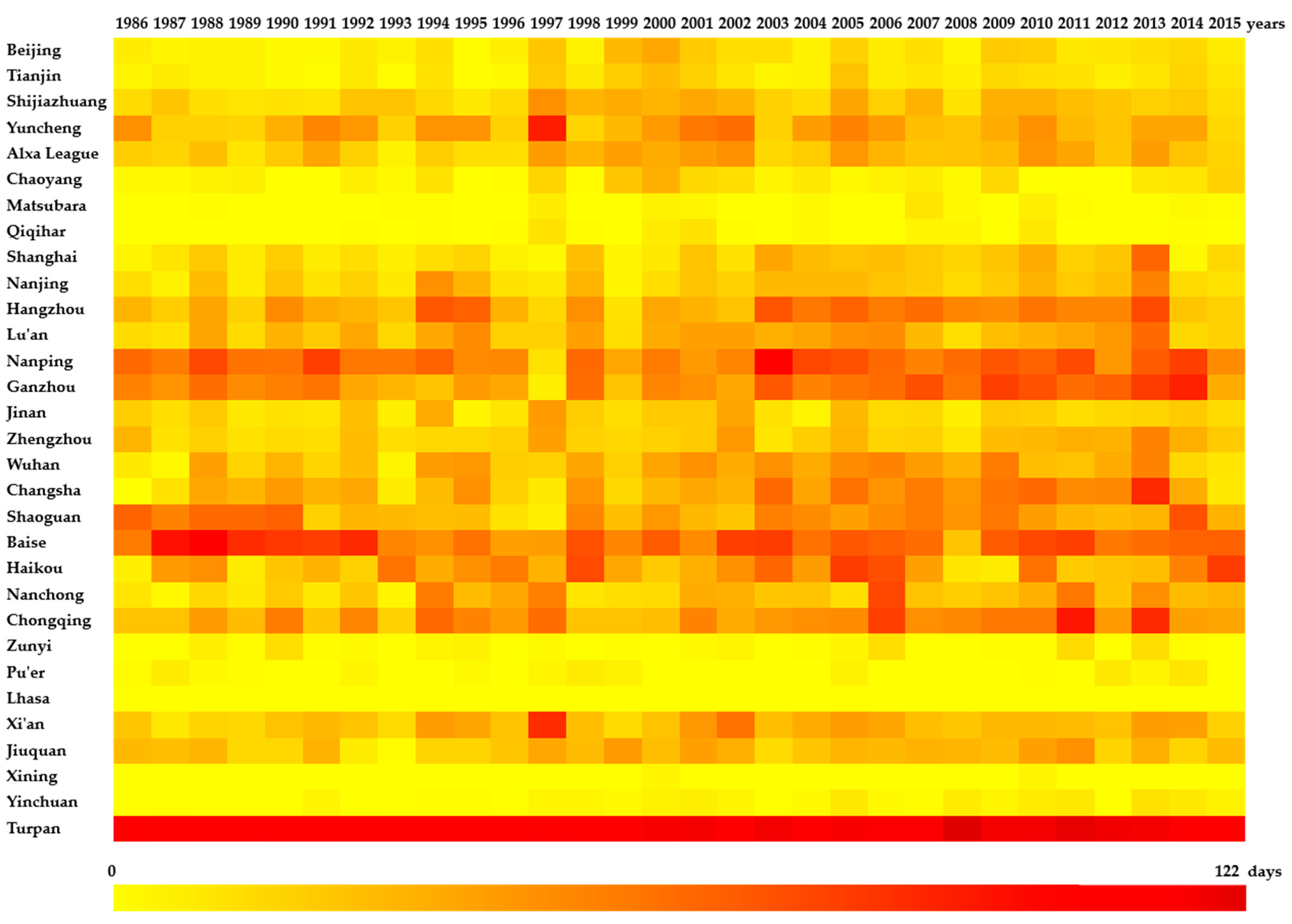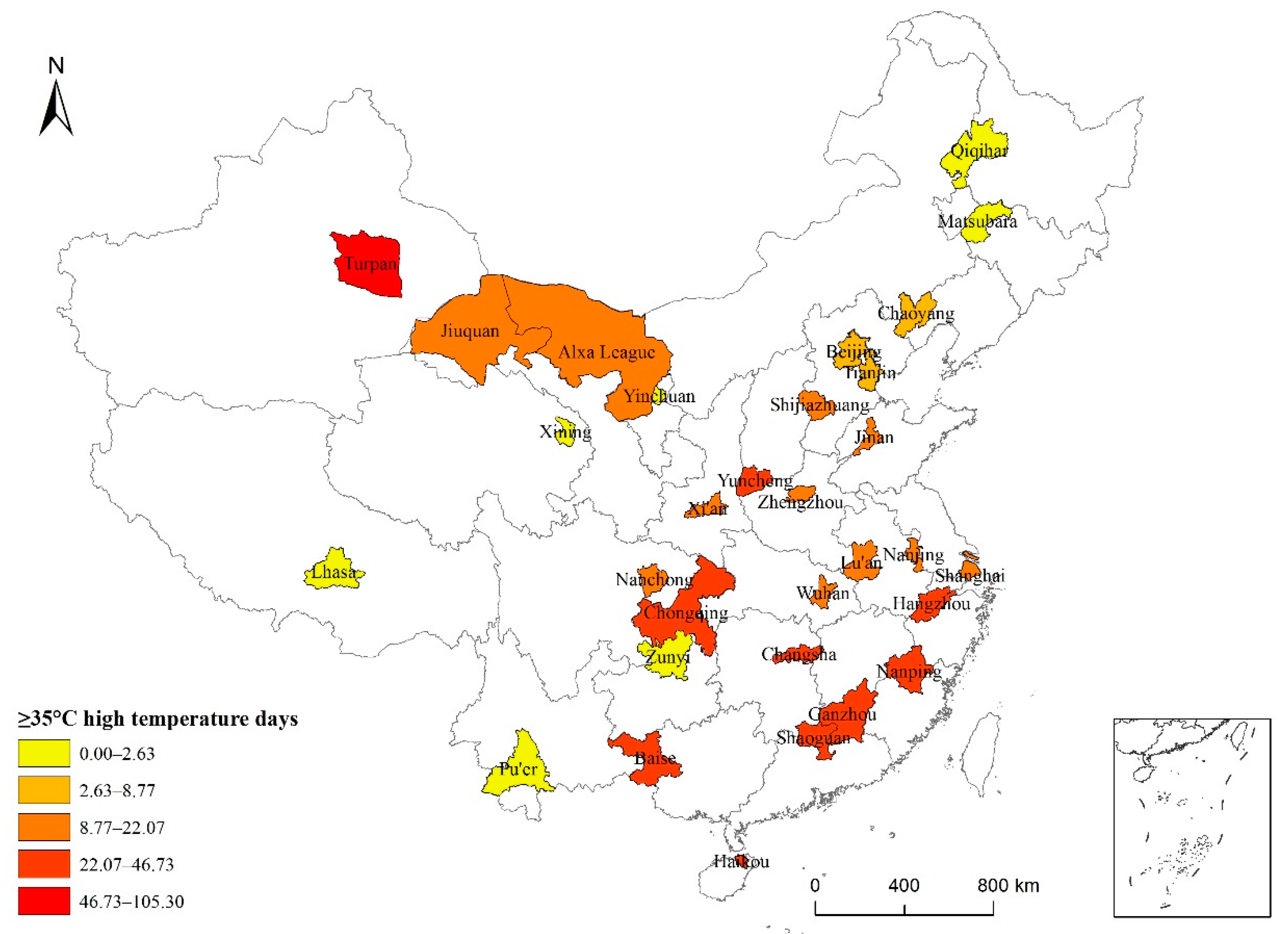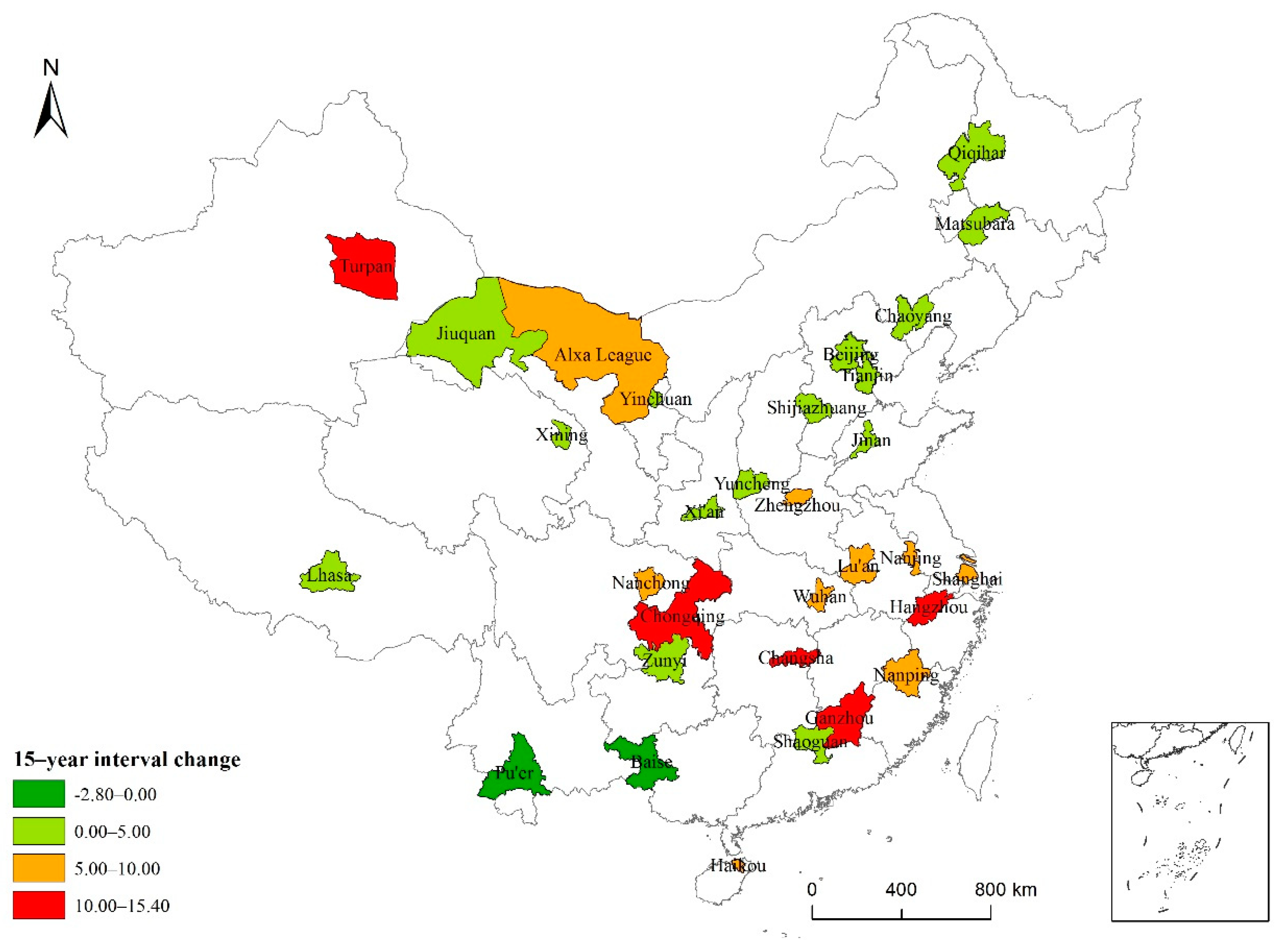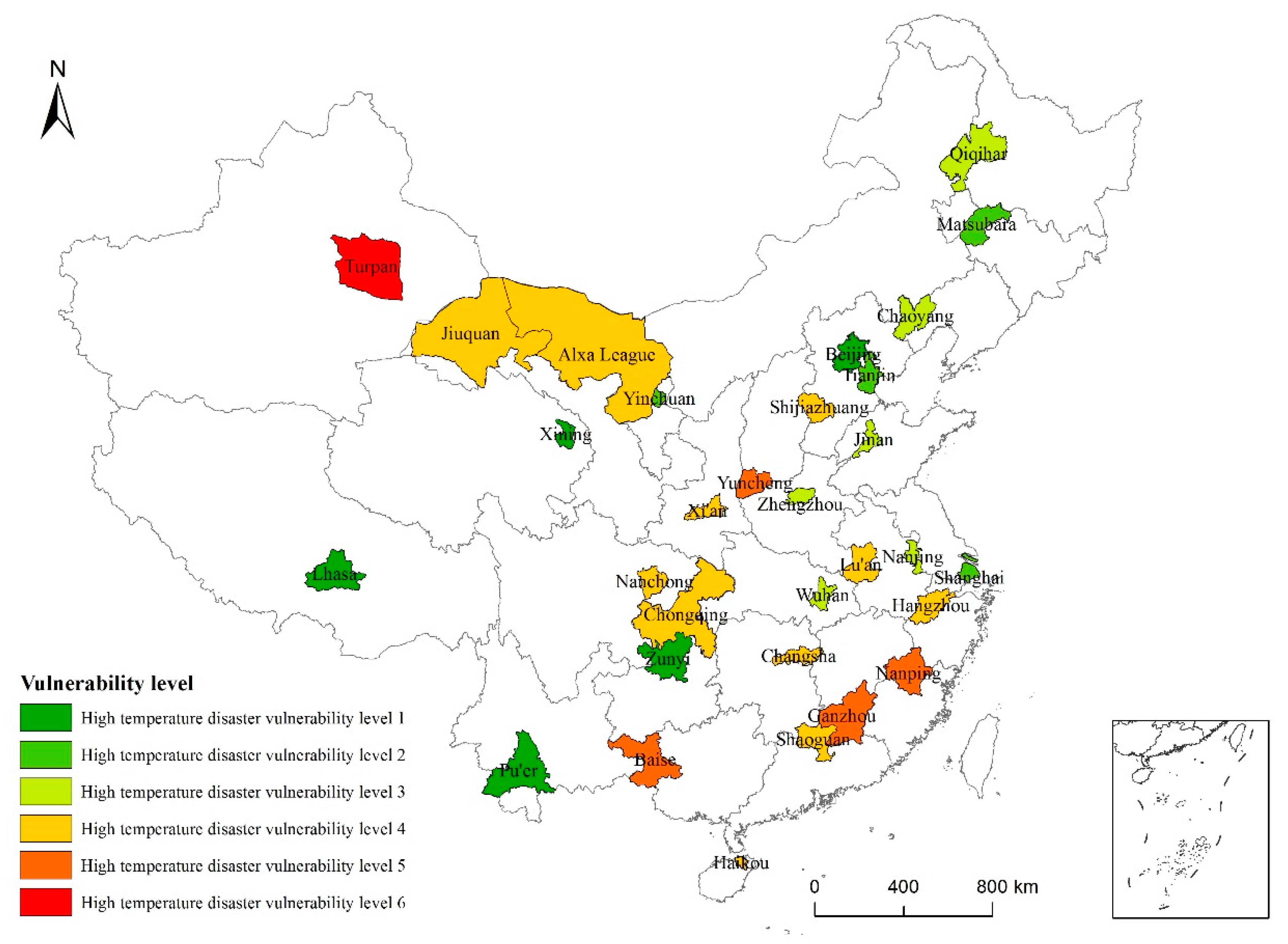Comprehensive Risk Assessment of Typical High-Temperature Cities in Various Provinces in China
Abstract
:1. Introduction
2. Data and Methods
2.1. Data
2.2. Methods
2.2.1. Analysis of High-Temperature Characteristics
2.2.2. Risk Analysis of High-Temperature Disasters
2.2.3. Vulnerability Analysis of High-Temperature Disaster and High-Temperature Risk Assessment
2.2.4. Jenks Natural Breaks
3. Results
3.1. Analysis of the Spatial and Temporal Characteristics of Urban High-Temperature Events
3.2. Risk and Vulnerability Analysis
3.3. Comprehensive Assessment of High-Temperature Risk
3.4. High-Temperature Risk Prevention Zoning
4. Discussion
4.1. Analysis of High-Temperature Spatiotemporal Characteristics and Comprehensive Risk Assessment
4.2. Spatial and Temporal Distribution Characteristics of High Temperatures in Typical Chinese Cities
4.3. High-Temperature Risk Assessment and Risk-Prevention Zoning in Typical Chinese Cities
5. Conclusions
Author Contributions
Funding
Institutional Review Board Statement
Informed Consent Statement
Data Availability Statement
Conflicts of Interest
Appendix A. PCA Analysis and SVI Calculation
| Eigenvalue | Contribution Rate | Cumulative Contribution Rate |
|---|---|---|
| 4.875 | 37.500 | 37.500 |
| 3.474 | 26.724 | 64.224 |
| 1.270 | 9.769 | 73.993 |
| 1.257 | 9.671 | 83.664 |
| Components of Component Function Matrix | ||||
|---|---|---|---|---|
| X | Z1 | Z2 | Z3 | Z4 |
| X11 | 0.015 | −0.073 | 0.623 | −0.208 |
| X12 | −0.140 | 0.313 | −0.146 | 0.049 |
| X13 | −0.083 | −0.008 | 0.017 | 0.767 |
| X14 | 0.199 | 0.010 | −0.066 | −0.107 |
| X15 | 0.002 | 0.240 | −0.040 | −0.028 |
| X16 | −0.045 | 0.283 | 0.008 | −0.067 |
| X21 | −0.109 | 0.302 | 0.200 | 0.043 |
| X22 | −0.076 | 0.068 | 0.576 | 0.262 |
| X23 | 0.198 | 0.038 | −0.056 | −0.231 |
| X24 | 0.188 | −0.130 | 0.109 | 0.108 |
| X25 | 0.212 | −0.015 | −0.014 | −0.112 |
| X26 | −0.210 | 0.203 | 0.037 | −0.286 |
| X27 | 0.229 | −0.066 | −0.034 | −0.045 |
References
- Easterling, D.R.; Meehl, G.A.; Parmesan, C.; Changnon, S.A.; Karl, T.R.; Mearns, L.O. Climate Extremes: Observations, Modeling, and Impacts. Science 2000, 289, 2068–2074. [Google Scholar] [CrossRef] [PubMed] [Green Version]
- Lott, J.N. The US summer of 1993: A sharp contrast in weather extremes. Weather 1994, 49, 370–383. [Google Scholar] [CrossRef]
- Guan, Z.; Yamagata, T. The unusual summer of 1994 in East A-sia: IOD teleconnections. Geophys. Res. Lett. 2003, 30, 1554. [Google Scholar] [CrossRef] [Green Version]
- McCarthy, J.J.; Canziani, O.F.; Leary, N.; Dokken, D.J.; White, K.S. Climate Change 2001: Impacts, Adaptation, and Vulnerability. Contribution of Working Group II to the Third Assessment Report of the Intergovernmental Panel on Climate Change (IPCC). Glob. Ecol. Biogeogr. 2001, 12, 87–88. [Google Scholar]
- Beniston, M.; Diaz, H.F. The 2003 heat wave as an example of summers in a greenhouse climate? Observations and climate model simulations for Basel, Switzerland. Glob. Planet. Chang. 2005, 44, 73–81. [Google Scholar] [CrossRef] [Green Version]
- Pascal, M.; Laaidi, K.; Ledrans, M.; Baffert, E.; Caserio-Schnemann, C.; Tertre, A.L.; Manach, J.; Medina, S.; Rudant, J.; Empereur-Bissonnet, P. France’s heat health watch warning system. Int. J. Biometeorol. 2006, 50, 144–153. [Google Scholar] [CrossRef] [PubMed]
- Sun, X.; Sun, Q.; Zhou, X.; Li, X.; Yang, M.; Yu, A.; Geng, F. Heat wave impact on mortality in Pudong New Area, China in 2013. Sci. Total Environ. 2014, 493, 789–794. [Google Scholar] [CrossRef]
- Bai, L.; Ding, G.; Gu, S.; Bi, P.; Su, B.; Qin, D.; Xu, G.; Liu, Q. The effects of summer temperature and heat waves on heat-related illness in a coastal city of China, 2011–2013. Environ. Res. 2014, 132, 212–219. [Google Scholar] [CrossRef] [Green Version]
- Hansen, A.L.; Bi, P.; Ryan, P.; Nitschke, M.; Pisaniello, D.; Tucker, G. The effect of heat waves on hospital admissions for renal disease in a temperate city of Australia. Int. J. Epidemiol. 2008, 37, 1359–1365. [Google Scholar] [CrossRef] [Green Version]
- Tian, Z.; Li, S.; Zhang, J.; Guo, Y.; Barengo, N.C. The Characteristic of Heat Wave Effects on Coronary Heart Disease Mortality in Beijing, China: A Time Series Study. PLoS ONE 2013, 8, e77321. [Google Scholar] [CrossRef]
- Mazdiyasni, O.; AghaKouchak, A. Substantial increase in concurrent droughts and heatwaves in the United States. Proc. Natl. Acad. Sci. USA 2015, 112, 11484. [Google Scholar] [CrossRef] [PubMed] [Green Version]
- Zaitchik, B.F.; Macalady, A.K.; Bonneau, L.R.; Smith, R.B. Europe’s 2003 heat wave: A satellite view of impacts and land-atmosphere feedbacks. Int. J. Climatol. 2006, 26, 743–769. [Google Scholar] [CrossRef]
- Parry, M. Climate Change 2007, Working Group II Contribution to the Fourth Assessment Report of the IPCC Intergovernmental Panel on Climate Change; Cambridge University Press: Cambridge, UK, 2007. [Google Scholar]
- Rosenzweig, C.; Solecki, W.D.; Parshall, L.; Chopping, M.; Pope, G.; Goldberg, R. Characterizing the urban heat island in current and future climates in New Jersey. Glob. Environ. Chang. Part B Environ. Hazards 2005, 6, 51–62. [Google Scholar] [CrossRef]
- Park, C.K.; Schubert, S.D. On the Nature of the 1994 East Asian Summer Drought. J. Clim. 2010, 11, 1056–1070. [Google Scholar] [CrossRef]
- Kalkstein, L.S.; Jamason, P.F.; Greene, J.S.; Libby, J.; Robinson, L. The Philadelphia Hot Weather-Health Watch/Warning System: Development and Application, Summer 1995. Bull. Am. Meteorol. Soc. 1996, 77, 1519–1528. [Google Scholar] [CrossRef] [Green Version]
- Kalkstein, L.S.; Greene, S.; Mills, D.M.; Samenow, J. An evaluation of the progress in reducing heat-related human mortality in major U.S. cities. Nat. Hazards 2011, 56, 113–129. [Google Scholar] [CrossRef]
- Yang, X.; Chen, B.; Kejia, H.U.; University, Z. A review of impacts of urbanization on extreme heat events. Prog. Geogr. 2015, 34, 1219–1228. [Google Scholar]
- Uejio, C.K.; Wilhelmi, O.V.; Golden, J.S.; Mills, D.M.; Gulino, S.P.; Samenow, J.P. Intra-urban societal vulnerability to extreme heat: The role of heat exposure and the built environment, socioeconomics, and neighborhood stability. Health Place 2011, 17, 498–507. [Google Scholar] [CrossRef]
- Johnson, D.P.; Stanforth, A.; Lulla, V.; Luber, G. Developing an applied extreme heat vulnerability index utilizing socioeconomic and environmental data. Appl. Geogr. 2012, 35, 23–31. [Google Scholar] [CrossRef]
- Bradford, K.; Abrahams, L.; Hegglin, M.; Klima, K. A Heat Vulnerability Index and Adaptation Solutions for Pittsburgh, Pennsylvania. Environ. Sci. Technol. 2015, 49, 11303–11311. [Google Scholar] [CrossRef]
- Junzhe, B.; Xudong, L.; Chuanhua, Y. The Construction and Validation of the Heat Vulnerability Index, a Review. Int. J. Environ. Res. Public Health 2015, 12, 7220–7234. [Google Scholar]
- Kates, R.W.; Colten, C.E.; Laska, S.; Leatherman, S.P. Reconstruction of New Orleans after Hurricane Katrina: A research perspective. Proc. Natl. Acad. Sci. USA 2006, 103, 14653–14660. [Google Scholar] [CrossRef] [PubMed] [Green Version]
- Nandy, S.; Singh, C.; Das, K.K.; Kingma, N.C.; Kushwaha, S.P.S. Environmental vulnerability assessment of eco-development zone of Great Himalayan National Park, Himachal Pradesh, India. Ecol. Indic. 2015, 57, 182–195. [Google Scholar] [CrossRef]
- Reid, C.E.; O’Neill, M.S.; Gronlund, C.J.; Brines, S.J.; Brown, D.G.; Schwartz, D.R. Mapping Community Determinants of Heat Vulnerability. Environ. Health Perspect. 2009, 117, 1730–1736. [Google Scholar] [CrossRef]
- Weber, S.; Sadoff, N.; Zell, E.; de Sherbinin, A. Policy-relevant indicators for mapping the vulnerability of urban populations to extreme heat events: A case study of Philadelphia. Appl. Geogr. 2015, 63, 231–243. [Google Scholar] [CrossRef]
- Wolf, T.; McGregor, G. The development of a heat wave vulnerability index for London, United Kingdom. Weather. Clim. Extrem. 2013, 1, 59–68. [Google Scholar] [CrossRef] [Green Version]
- Masozera, M.; Bailey, M.; Kerchner, C. Distribution of impacts of natural disasters across income groups: A case study of New Orleans. Ecolog. Econ. 2007, 63, 299–306. [Google Scholar] [CrossRef]
- Harlan, S.L.; Brazel, A.J.; Prashad, L.; Stefanov, W.L.; Larsen, L. Neighborhood microclimates and vulnerability to heat stress. Soc. Sci. Med. 2006, 63, 2847–2863. [Google Scholar] [CrossRef]
- Alexander, L.V.; Allen, S.K.; Bindoff, N.L.; Bréon, F.-M.; Xie, S.P. Climate change 2013: The physical science basis, in contribution of Working Group I (WGI) to the Fifth Assessment Report (AR5) of the Intergovernmental Panel on Climate Change (IPCC). Comput. Geom. 2013, 129, 83–103. [Google Scholar]
- CSDGSND. Understanding the Changing Planet: Strategic Directions for the Geographical Sciences; CSDGSND: La Prairie, QC, Canada, 2010.
- Asian, D.R.C. Living With Risk: A Global Review of Disaster Reduction Initiatives; United Nations: Geneva, Switzerland, 2002. [Google Scholar]
- Adrianto, L.; Matsuda, Y. Developing economic vulnerability indices of environmental disasters in small island regions. Environ. Impact Assess. Rev. 2002, 22, 393–414. [Google Scholar] [CrossRef]
- Katz, R.W. Stochastic Modeling of Hurricane Damage. J. Appl. Meteorol. 2002, 41, 754. [Google Scholar] [CrossRef] [Green Version]
- Lekes, V.; Dandul, I. Using airflow modelling and spatial analysis for defining wind damage risk classification (WINDARC). For. Ecol. Manag. 2000, 135, 331–344. [Google Scholar] [CrossRef]
- Lynch, A.H.; Cassano, E.N.; Cassano, J.J.; Lestak, L.R. Case Studies of High Wind Events in Barrow, Alaska: Climatological Context and Development Processes. Mon. Weather. Rev. 2003, 131, 719. [Google Scholar] [CrossRef]
- Whiteman, C.D.; Doran, J.C. The Relationship between Overlying Synoptic-Scale Flows and Winds within a Valley. J. Appl. Meteor. 2010, 32, 1669–1682. [Google Scholar] [CrossRef] [Green Version]
- Moore, J.; Quine, C.P. A comparison of the relative risk of wind damage to planted forests in Border Forest Park, Great Britain, and the Central North Island, New Zealand. For. Ecol. Manag. 2000, 135, 345–353. [Google Scholar] [CrossRef]
- Blaikie, M.P. At Risk: Natural Hazards, People’s Vulnerability and Disasters; Routledge: London, UK, 1994; pp. 147–167. [Google Scholar]
- Petak, W.J.; Atkisson, A.A. Natural Hazard Risk Assessment and Public Policy; Springer: New York, NY, USA, 1982. [Google Scholar]
- Yao, R.; Hu, Y.; Sun, P.; Bian, Y.; Liu, R.; Zhang, S. Effects of urbanization on heat waves based on the wet-bulb temperature in the Yangtze River Delta urban agglomeration, China. Urban Clim. 2022, 41, 101067. [Google Scholar] [CrossRef]
- Nelson, K.S.; Abkowitz, M.D.; Camp, J.V. A method for creating high resolution maps of social vulnerability in the context of environmental hazards. Appl. Geogr. 2015, 63, 89–100. [Google Scholar] [CrossRef]
- Aubrecht, C.; Özceylan, D. Identification of heat risk patterns in the U.S. National Capital Region by integrating heat stress and related vulnerability. Environ. Int. 2013, 56, 65–77. [Google Scholar] [CrossRef]
- El-Zein, A.; Tonmoy, F.N. Assessment of vulnerability to climate change using a multi-criteria outranking approach with application to heat stress in Sydney. Ecol. Indic. 2015, 48, 207–217. [Google Scholar] [CrossRef] [Green Version]
- Vescovi, L.; Rebetez, M.; Rong, F. Assessing public health risk due to extremely high temperature events: Climate and social parameters. Clim. Res. 2005, 30, 71–78. [Google Scholar] [CrossRef]
- Ebert, U.; Welsch, H. Meaningful environmental indices: A social choice approach. J. Environ. Econ. Manag. 2004, 47, 270–283. [Google Scholar] [CrossRef]
- Xie, P.; Wang, Y.L.; Liu, Y.X.; Peng, J. Incorporating social vulnerability to assess population health risk due to heat stress in China. Acta Geogr. Sin. 2015, 70, 1041–1051. [Google Scholar]
- North, M.A. A Method for Implementing a Statistically Significant Number of Data Classes in the Jenks Algorithm. In Proceedings of the 2009 Sixth International Conference on Fuzzy Systems and Knowledge Discovery, Tianjin, China, 14–16 August 2009; pp. 35–38. [Google Scholar]
- Siyan, D.; Ying, X.; Botao, Z.; Meiting, H.; Yongxiang, Z. Projected Risk of Extreme Heat in China Based on CMIP5 Models. Adv. Clim. Change Res. 2014, 10, 365–369. [Google Scholar]








| Data Types | Data Description | Data Sources | Time Period |
|---|---|---|---|
| Meteorological data | Daily maximum temperatures from 194 meteorological stations | National Meteorological Science Data Sharing Center (http://data.cma.cn/site/index.html, accessed on 15 Apirl 2020) | 1986–2015 |
| Socio-economic data | Statistical data, including population, employment, income, finance, industry, education, healthcare, and other data from various administrative areas | Provincial statistical yearbooks from Anhui, Gansu, Guangdong, Guangxi, Hebei, Henan, Heilongjiang, Hubei, Hunan, Jilin, Jiangxi, Liaoning, Inner Mongolia, Shandong, Shanxi, Sichuan, Tianjin, Tibet, Xinjiang, Yunnan, Chongqing, Shanghai, Hainan, Beijing, Zhejiang, Guizhou, Qinghai, and Ningxia. Municipal statistical yearbooks from Nanjing, Nanping, Wuhan, Chaoyang, Shijiazhuang, Xi’an, Yuncheng, Kunming, and Zunyi. Statistical yearbooks are all from provincial and municipal statistical bureaus. | 2016 |
| Statistics (As supplementary materials) | Heilongjiang Financial Yearbook and the national, economic, and social development statistical bulletins from the cities of Ganzhou and Pu ’er and other provinces and cities, provided by the Provincial and Municipal Statistics Bureau | 2015 |
| Statistical Metric | Tianjin | Shanghai | Ganzhou | Zhengzhou | Changsha | Nanchong | Chongqing | Yinchuan | Turpan |
|---|---|---|---|---|---|---|---|---|---|
| Pearson correlation | 0.368 * | 0.460 * | 0.488 ** | 0.443 * | 0.526 ** | 0.424 * | 0.465 ** | 0.679 ** | 0.614 ** |
| Sig. (2-tailed) | 0.045 | 0.011 | 0.006 | 0.014 | 0.003 | 0.020 | 0.010 | 0.000 | 0.000 |
| N | 30 | 30 | 30 | 30 | 29 | 30 | 30 | 30 | 30 |
| Primary Indicator | Sub-Indicator |
|---|---|
| Sensitivity | Proportion of the population that is female (%) |
| Proportion of the population that works in the primary industry (%) | |
| Registered unemployment rate (%) | |
| Number of students in primary school (people) | |
| Adaptability | Per capita disposable income of urban residents (CNY) |
| Per capita disposable income of rural residents (CNY) | |
| Basic endowment insurance for urban workers (CNY) | |
| GDP per capita (CNY) | |
| Proportion of industrial output value in GDP (%) | |
| Local fiscal revenue (CNY 10,000) | |
| Number of health technicians (people) | |
| Local financial education expenditure (CNY 10,000) | |
| Social security and employment expenditure (CNY 10,000) |
Publisher’s Note: MDPI stays neutral with regard to jurisdictional claims in published maps and institutional affiliations. |
© 2022 by the authors. Licensee MDPI, Basel, Switzerland. This article is an open access article distributed under the terms and conditions of the Creative Commons Attribution (CC BY) license (https://creativecommons.org/licenses/by/4.0/).
Share and Cite
Zhang, X.; Long, Q.; Kun, D.; Yang, D.; Lei, L. Comprehensive Risk Assessment of Typical High-Temperature Cities in Various Provinces in China. Int. J. Environ. Res. Public Health 2022, 19, 4292. https://doi.org/10.3390/ijerph19074292
Zhang X, Long Q, Kun D, Yang D, Lei L. Comprehensive Risk Assessment of Typical High-Temperature Cities in Various Provinces in China. International Journal of Environmental Research and Public Health. 2022; 19(7):4292. https://doi.org/10.3390/ijerph19074292
Chicago/Turabian StyleZhang, Xueru, Qiuyue Long, Dong Kun, Dazhi Yang, and Liu Lei. 2022. "Comprehensive Risk Assessment of Typical High-Temperature Cities in Various Provinces in China" International Journal of Environmental Research and Public Health 19, no. 7: 4292. https://doi.org/10.3390/ijerph19074292
APA StyleZhang, X., Long, Q., Kun, D., Yang, D., & Lei, L. (2022). Comprehensive Risk Assessment of Typical High-Temperature Cities in Various Provinces in China. International Journal of Environmental Research and Public Health, 19(7), 4292. https://doi.org/10.3390/ijerph19074292







